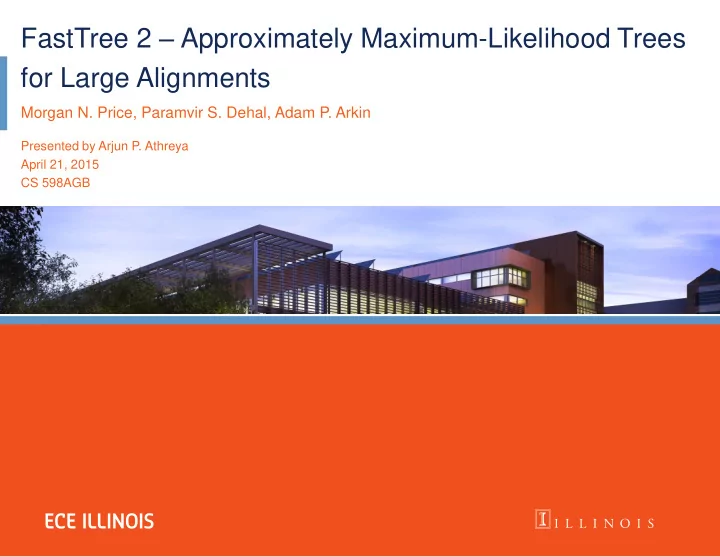

FastTree 2 – Approximately Maximum-Likelihood Trees for Large Alignments Morgan N. Price, Paramvir S. Dehal, Adam P. Arkin Presented by Arjun P. Athreya April 21, 2015 CS 598AGB
Fast Tree 2 Five stages of computation – Heuristic neighbor-joining (NJ) – Tree length reductions • Nearest-neighbor interchanges (NNI) • Subtree-prune-regraft (SPR) moves • Distance model – Maximum Likelihood with NNIs – Local support values
Heuristic NJ C A Produces rough topology B D Optimization: – Profile for internal nodes instead of a distance-matrix (space saving!) – Remembers best join for each node – Remembers top pair-wise distances (space saving!) – Updates best join for a node as it traverses
Tree-length reductions : NNI Topology refinement C A ? B D A C B A ? ? B D C D Optimization: work with profiles, than pairwise distances (space saving!) – – 2 log(N) rounds of NNI Space: Time:
SPR moves A subtree is removed from the tree, reinserted somewhere else B A A C D C B E E D Optimization: – Consider shortest SPRs first, and then extends the promising candidates (space savings!) – For each subtree, only two SPR moves (time saving!)
Maximum Likelihood Improve tree-topology and branch lengths Jukes-Cantor model, accounts for variable rates (20 categories, geometrically distributed) Operation: – Likelihood of trees generated using NNI – Estimate branch lengths Optimizations: – Stop NNI if likelihood of rearrangements are not improving – NNI restricted to 2log(N) – Skip SPR in parts of tree that did not improve in recent rounds
Results: Metric: RF distances FastTree outperforms other tools which don’t use SPR’s
Results: likelihoods on biological data RAxML still better Exhaustive ML search still wins
Results: RAxML vs FastTree2 • But, FastTree found 96-98% of splits RAxML found • Heuristics did not affect the results much and performed as expected compared to simulated data
Results: Runtime Would take years!
Results: Likelihood over time RAxML with same starting tree as FastTree shows similar improvement in likelihood with time
Conclusion FastTree2 makes intelligent decisions on improving speed while maintaining pretty good accuracy Impact of heuristics, computational tricks do not impact results a lot RAxML is still a winner for accuracy, but at the cost of time (may never complete for large datasets) – Personal experience on running FastTree 2 and RAxML for course project, 1 minute vs 30 minutes on small amino acid data
Recommend
More recommend